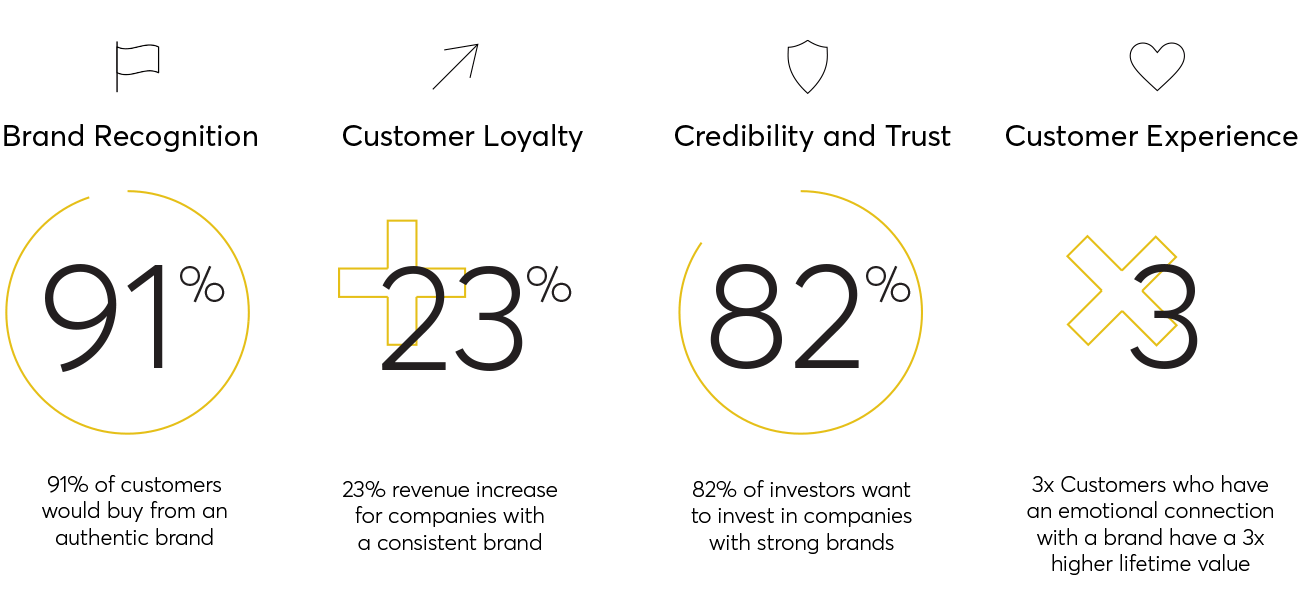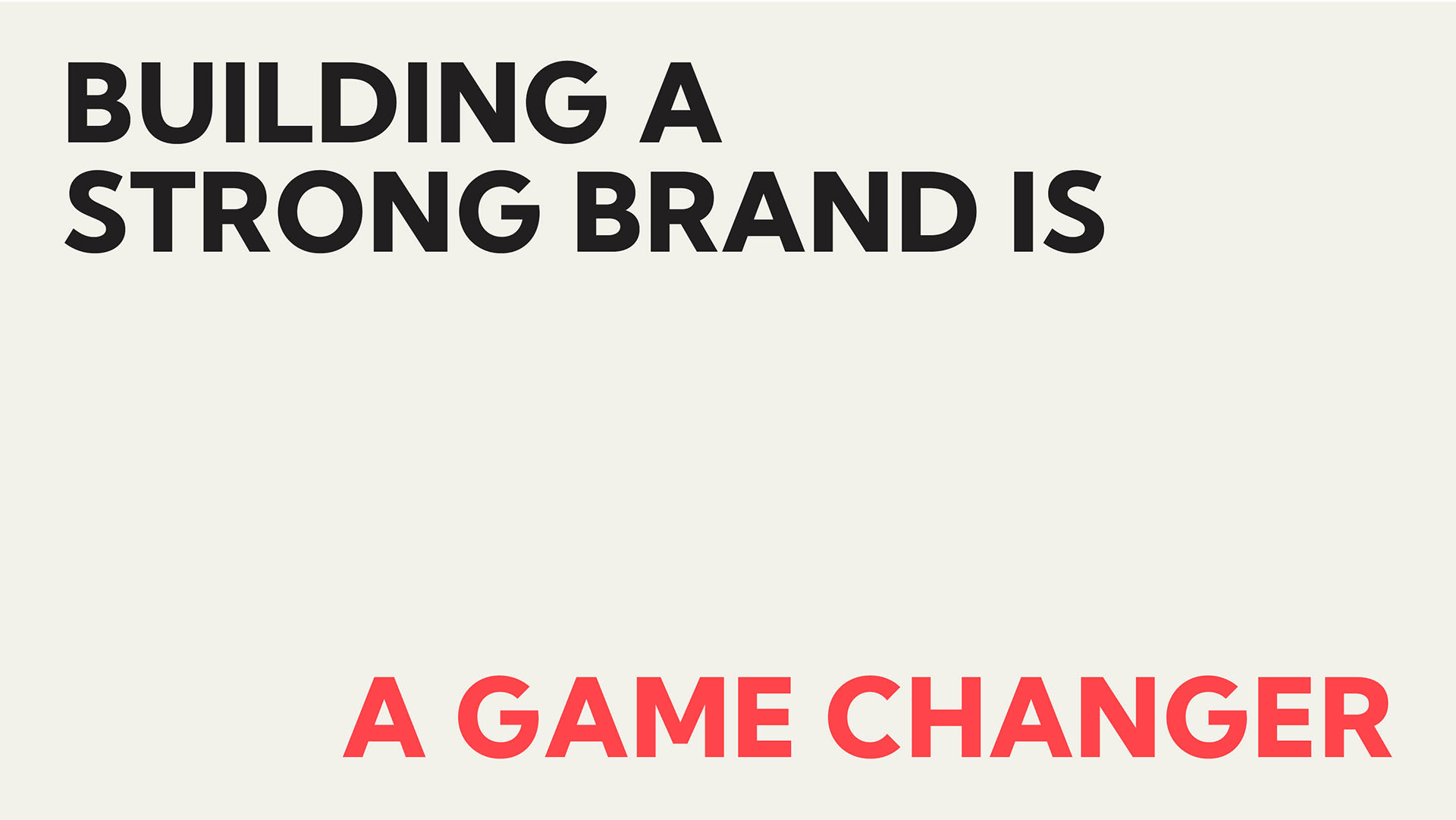What is branding, why it’s important for your business, and how to get it right
WHAT IS BRANDING?
A brand is often thought of simply as the logo and colours of a business. But it is much more than that. In fact, the visual identity is one of the last steps in creating a unique, memorable and strong brand.
So what exactly is branding then? Fundamentally, a brand is how people perceive your business. It’s your values, your purpose, your personality. A brand is how your business makes someone feel.
“Brand is the sum total of how someone perceives an organisation. Branding is about shaping that perception,” says Ashley Friedlein, founder of Econsultancy.
Or, as the CEO of Amazon, Jeff Bezos, says: “Your brand is what people say about you when you’re not in the room.”
A brand starts with a process of differentiation. It’s about analysing what makes your offering worthy of your customer’s time and money. Why should they choose you? Why not choose your competitor? What is so good about your brand that they should become an ambassador?
Once you know who you are, you have to live and breathe it through every single part of your business. Through every aspect of your company, every customer interaction. Consistency in brand building is absolutely paramount.
For example, imagine if you walked into an Apple Store to soft furnishings and an Apple Genius clothed in tracksuit pants. Or imagine if Red Bull suddenly started sponsoring flower arranging instead of base jumping.
HOW DOES BRANDING ADD VALUE TO A BUSINESS?
There are lots of benefits of a strong brand, but defining, creating, and managing your brand is no small task. It takes dedication, understanding, and an ongoing commitment. But the results of effective branding can truly add value, with 91 percent of customers more willing to buy from an authentic brand, and consistent branding proven to increase revenue by up to 23 percent.
If you’re still wondering why does branding matter then hopefully these stats will convince you.

The benefits of building a strong, strategic brand are endless. You’ll reap the rewards of better brand recognition and brand awareness, and in turn, build credibility, loyalty and trust with your customers.
WHAT IS BRAND EQUITY?
When talking about the benefits of a strong brand, you may hear the term brand equity used. This is the term used to describe the value of having a recognised brand.
Brand equity has four core areas:
- Brand awareness – high brand recall means a company and its products are highly familiar and instantly recognisable
- Perceived quality – customers have an innate trust in the quality of a company’s products
- Brand association – what does a brand make you think of? How does it make you feel?
- Brand loyalty – this is the gold standard of effective branding, increasing customer spend and reducing marketing costs
Let’s take the master of brand-building, Coca-Cola for example. With Coca-Cola, you always know what to expect and you trust the brand to deliver it every time.
One of the founding personality traits of Coca-Cola is happiness, joy, and fun. And this comes across in their branding at all times. Remember the Coca-Cola bottles with names on? A perfect example of a brand coming to life through its products.
A side benefit of the above is an improved customer experience. When a customer knows what to expect from a brand – and you deliver it flawlessly at every step – they have a superior experience. As their trust grows, so does their emotional attachment, and loyalty.
THE BRANDING PROCESS
As you now know, there is plenty more to branding than simply a logo and colour palette. But luckily, there is a proven branding process to follow which will help you to create a powerful and lasting brand.
STEP 1: WRITE A BRAND POSITIONING STRATEGY
Developing your brand strategy is the most important step in the branding process. It will outline who you are, what you stand for, why you exist and the values that drive all behaviour. Every decision your business makes moving forward should be measured against this strategy. It’s your sense check to make sure your brand remains authentic and consistent.
In order to create an effective brand strategy two key components are required:
Develop a deep understanding of the business
For the deep dive into the business, a branding workshop is conducted with all major stakeholders. The aim? To discuss every aspect of your business – honestly, and get all stakeholders aligned. A variety of activities are designed to draw out all the information required, information that you may not think to convey consciously. Additional sources of information may be employee interviews, stakeholder interviews, plus competitor and industry research.
Understand your most desired customer
Next up it’s the all-important customer research. Think focus groups, guerilla research, surveys, in-depth one-on-one interviews. This step is so important; you cannot guess what your customers (or potential customers) think. The research almost always uncovers surprising and unknown insights that go on to inform your brand and messaging. If you’d like more information, we’d suggest reading this article on whether your brand needs consumer research.
Write your brand strategy document
The brand strategy document pulls together the insights from the customer research and the business workshop. It acts as a blueprint for all business, brand and marketing decisions in the future. A strategy document will cover; target audience, key messaging, points of difference, brand personality, mission, vision and values.
Don’t let your brand strategy live in a drawer
When a new opportunity comes knocking at your door, your brand strategy should be what you pull out to really consider – is this aligned to where we are headed? Does it fit with our values? Or is it a shiny distraction?
Also, whenever you write something – a website, a brochure, social media – revert back to your brand strategy and ensure what you’re doing is aligned. If you’re ready to grow your brand, you’ll need your brand strategy.
STEP 2: BRINGING YOUR BRAND TO LIFE
Now it’s time for the fun part… and the part you’ve all been waiting for no doubt. Once you have your strategy defined, it is time to bring it to life with your visual and verbal identity.
Visual brand identity
Your visual identity includes your brand mark (logo), typography style, colour palette, graphic devices, photography style and a system (guidelines) for how all of these elements work together.
Now you have your strategy set it’s much easier to judge what visual identity works for your business. It’s less about ‘Mum doesn’t like blue’ and my friend Sarah ‘doesn’t like the use of circles’ and more about whether your visual identity reflects your brand strategy.
Seriously, you should never listen to your Mum (or anyone else for that matter) when it comes to branding – unless they have a deep understanding of your target audience and are assessing against your strategy.
Let’s go back to the Apple example. Apple’s brand is built around simplicity. If its visual style used an ornate illustration of an apple tree and a bright colour palette instead of its clean look and feel, it would not clearly reflect who they are.
Verbal brand identity/tone of voice
How your brand sounds is just as important as how it looks. Developing a clear verbal identity will give you all of the tools you need to ensure your brand’s use of language (how it ‘talks’) is consistent and aligned.
The verbal identity usually consists of a tone of voice document – which outlines some simple and usable guidelines you can work with. These establish a consistent style for communication across all channels – from how emails are answered, to how you communicate your brand messaging on your website and in the media. It’s also a great briefing tool for internal and external content producers.
An example of a company with a clear and consistent tone of voice is Mailchimp. The email service is held up in the industry (and rightly so) as being a pioneer of the power of a strong verbal identity.
Its voice is professional yet friendly and talks to you as if you were… well… human. As we write this, Mail Chimp’s home page reads ‘You’re ready to grow. Now what?’ and further down the page ‘What Mailchimp can do for you’.
If their tone of voice had been more corporate and less friendly, for example, these could read ‘Grow your business with Mailchimp’ and ‘Mailchimp’s features’.
Want more inspiration? We’d highly recommend taking a read of their very extensive content style guide.
STEP 3: EMPLOYER BRANDING
There’s no point in having a strong brand externally if you’re not living and breathing it internally. We won’t go into this in full detail here as employer branding is an entire process in and of itself (watch this space as we’ll be writing about this soon), but companies who are serious about creating a strong and resilient brand need to be looking at internal implementation.
From initial employee engagement at research stages, to ensuring employees are empowered and encouraged to live the brand values, your employees – and internal brand implementation – will play a vital role in your brand’s success. The quickest way to excellent customer experience? Happy and engaged staff aligned to your purpose and values. Your team are the lifeblood of your business.
STEP 4: BRAND COLLATERAL
Okay, you’ve got your strategy. You’ve got your visual identity. You’ve got your tone of voice. Now, it’s time to roll it out across every touchpoint of your business.
Complete an audit
The first step is to complete an audit of all of your existing touch-points. By this, we mean every single touchpoint, piece of collateral or process in your business. Ask yourself… Does it align with your strategy? Does it looks and feel like your brand? If not, it will need updating, improving, or perhaps losing all together. Still not convinced? Here’s why your brand needs an audit.
Update collateral
Once you know what needs doing, prioritise accordingly. Often the most important things to change are items like packaging, sales processes, brochures etc – items that are customer-facing. Once prioritised, work through the items – redesign and rewrite. A lot of work? Yes. Worth it? Definitely. And make sure you have the right team – internally, externally or a combination of the two – who can do your brand justice. Not only are the aesthetics of your collateral really important but so is the quality of the content. We believe that copywriting is an undervalued brand asset and well worth investing in.
Website
Websites in many cases are the most critical brand touchpoint. Your website is your global sales team that works 24/7 – this prime real estate needs to be maximised. It should be one of the first things you look at bringing into line with your new brand identity. Consider user testing to really ensure this asset is as powerful as possible. For simpler sites, there are template-based options, and third-party systems, to minimise development costs. This allows greater investment in photographic and content assets, or in other cases, with more specific requirements a custom site may need to be developed. If you’d like to know more we explore in detail the differences between template-based and custom website development.
STEP 5: ONGOING COMMUNICATIONS
It’s time to breathe a sigh of relief. Your strategy is set. Your visual and verbal identity is agreed. And every touchpoint in your business is now aligned. You’re done, right? We’re afraid not! After all that hard work, it’s vital to ensure that your brand strategy isn’t forgotten and left to gather dust in a draw.
Customer journey
If you really want to make your brand sing, try mapping your customer journey. This will show you every touchpoint your customer has with your brand, or potentially missed opportunities where you could really surprise and delight. A customer journey workshop is a great launchpad for defining your marketing strategy and then prioritising its implementation. You can look at your must have ‘business-as-usual’ activities and then where you can really take things up a level.
Content
Content, content, content. It’s all about content. Content is the way that your product or service manifests in the world. It is the connective tissue between you and your audience. If you want your marketing to deliver results, and not to feel like you are overwhelmed in the process, you must have a content strategy in place, and a systemised, batch method of creating content. Read our step by step guide on creating content that converts.
Regular audits
Conduct regular brand audits to ensure your brand hasn’t wavered, and make sure every new piece of collateral, campaign, or business decision is still aligned.
BUILDING A BRAND FOR LIFE
“A brand is a living entity — and it is enriched or undermined cumulatively over time, the product of a thousand small gestures,” Michael Eisner, CEO of Disney.
This statement couldn’t be truer. The development of a brand is just step one. The real power comes through nurturing it, and ensuring it remains a brand that your employees and customers believe in.
It’s the consistency in execution that really brings power to your brand. This means being rigorous and disciplined in the many different ways your brand is expressed.
Make sure you do share your brand guidelines and brand strategy with key partners working on your brand. And in the case where there are many third parties, it is essential to have a brand guardian.
A brand guardian can be someone within the business that is experienced at building and managing brands, or potentially a central agency that ensures integrity of the vision over time – regardless of how many other agencies may be involved.
NEED BRANDING ADVICE?
At Tiny Hunter, our passion is deeply rooted in our commitment to create brands that make an impact and stand the test of time. We believe that every business should have access to the expertise needed to succeed.
Get in touch to see how we can help your business grow or sign up for or our Branding Before Breakfast video series for bite sized branding advice delivered to your inbox weekly.








